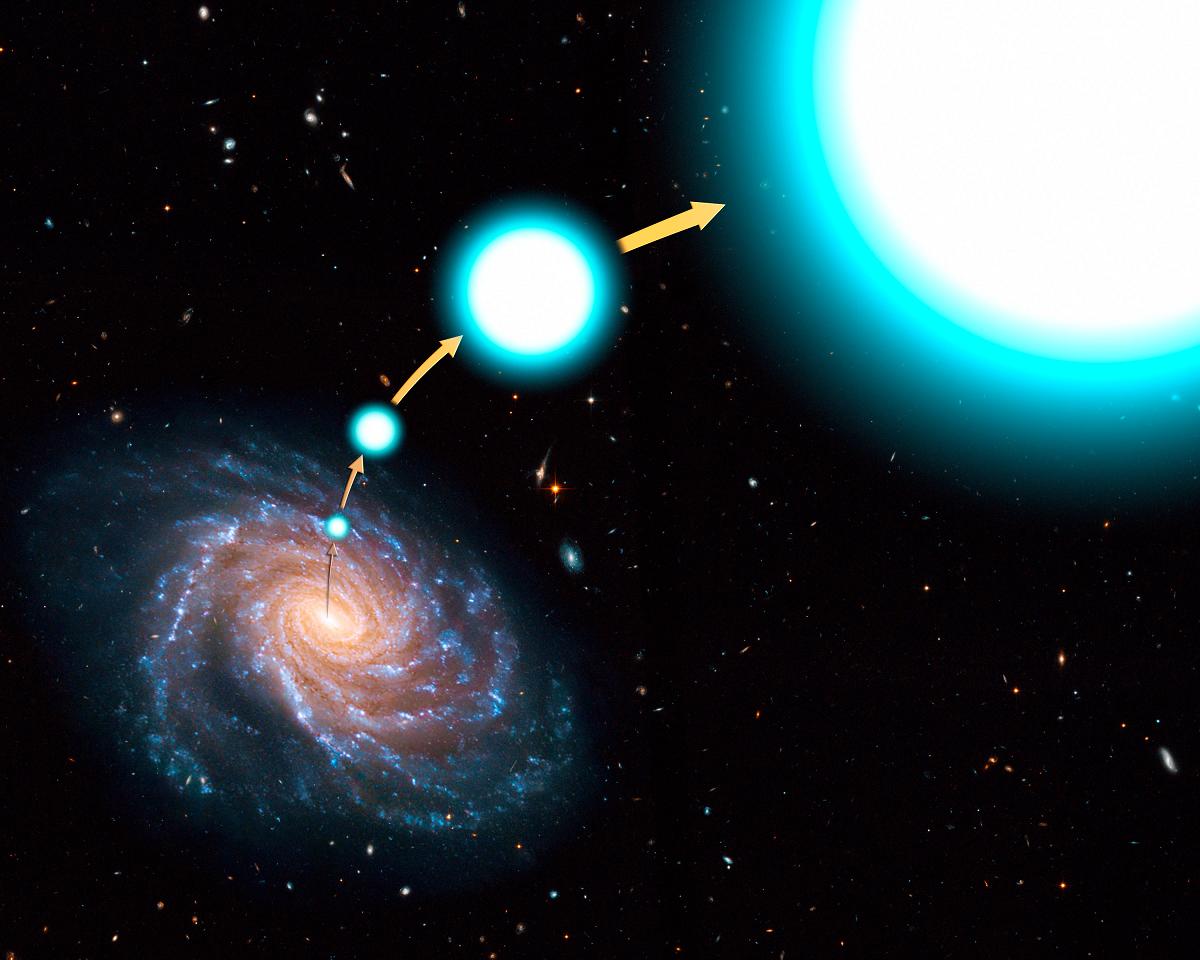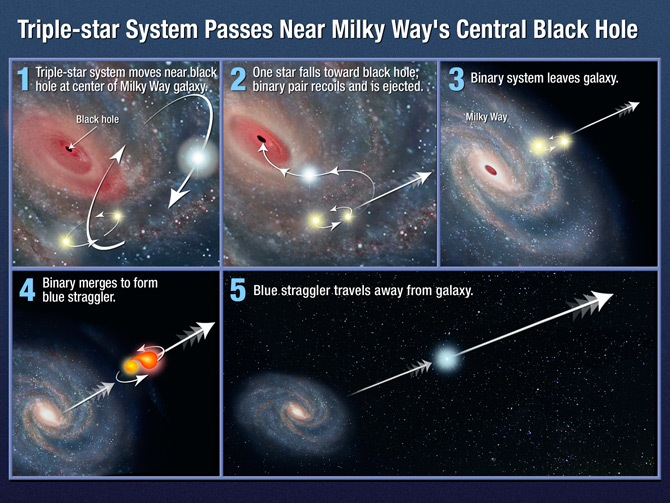A game of cosmic billiards - a trio of stars approached the black hole - one fell into it, the other two merged into one star and flew out of the galaxy. This is not science fiction, Hubble discovered such a star

This story sounds like something out of the wild imaginations of science fiction writers, but astronomers using the Hubble Space Telescope said this is the biggest scenario for the creation of a super-fast star, named HE 0437-5439. This star is one of the fastest discovered so far. It crosses the sky at a speed of 2.5 million km/h, 3 times faster than the peripheral speed of our Sun at the center of the Milky Way. Hubble's observations confirmed that the accelerating star comes from the core of the Milky Way, causing confusion as to its true origin.
"Using Hubble we could for the first time trace back in time and examine where the star came from by measuring the direction of its movement in the sky. The motion points directly out from the center of the Milky Way," said Warren Brown, an astronomer at the Harvard-Smithsonian Center for Astrophysics in Cambridge, Massachusetts, and a member of the Hubble team that observed the star. "These alien stars are rare among the Milky Way's population of one hundred billion stars. For every 100 million stars in the galaxy, there is one extremely fast star."
The movement of these free stars can reveal to us the distribution of dark matter surrounding our galaxy "The study of these stars can provide us with additional clues about the nature of the invisible mass of the universe, and it can also help astronomers better understand how galaxies form" said Oleg Gendin from the University of Michigan Ban Harbor "The gravitational push of dark matter is measured by the shape of the orbits of extremely fast stars as they exit the Milky Way."
This stellar outlier is already crossing the outer rim of the Milky Way galaxy far above the galactic plane and about 200 thousand light years from the center. For comparison, the diameter of the Milky Way is about 100 thousand light years. By measuring the direction of motion of the accelerating stars and setting the Milky Way's core as a starting point, Brown and Gendin's team calculated how fast these stars would have had to be ejected to reach their current location.
"The star is moving at an absurd speed, twice what is required to escape the gravitational field of the galaxy," explains Brown, a hunter of extremely fast stars who discovered the first star of this type in 2005. "There is no star that can move at such a high speed under normal conditions, so something exotic must have happened. "
There is a twist in the plot. Based on the speed and position of HE 0437-5439, the researchers concluded that the star would have to be at least 100 million years old to reach the vicinity of the Milky Way's core. However, its mass - 9 times the mass of the Sun and its blue color indicate that it had to burn up completely after 20 million years, a much shorter time than the time it took to reach its current location.
The best explanation for the star's blue color and tremendous speed is that it was part of a triple star system engaged in a game of cosmic gravitational billiards with the supermassive black hole at the center of the galaxy. This concept about the way to give high initial speed was first proposed in 1988. The theory predicts that the black hole at the center of the Milky Way may emit one star every 100 years.
Brown proposes a theory that the ternary system contained a pair of two stars orbiting each other closely and a third member also gravitationally bound to the group. The black hole began to pull the outer star out of the pair's tight gravitational system. The momentum of the unlucky star was transferred to the pair and launched it at a speed that would carry it out of the galaxy. As a pair of stars continued to accelerate through the sky, they went through the normal process of stellar evolution. The more massive star of the two evolved at a faster rate, swelling up and becoming a red giant. He enveloped his partner and the two began to spin together until they merged into one star - the blue straggler. "Although the story of the blue wanderer sounds strange, many like them can be seen in the Milky Way and most are found in multiple star systems." Brown said.
The wandering star has been an enigma to astronomers since it was discovered in 2005 by a sky survey of the European Southern Observatory. Astronomers have proposed two options to solve the age problem. Either the star managed to dip in the fountain of youth and became a blue drifter or it is simply a refugee from the large magellanic cloud - a nearby galaxy.
In 2008, a team of astronomers believed that his men had succeeded in solving the mystery. They found a match between the chemical composition of the exoplanet and characteristics of stars in the Large Magellanic Cloud. The general location of the star is also close to this galaxy, only 65 thousand light years away. Hubble's latest results settle the debate as to the birthplace of the star.
The astronomers used the sharp vision of Hubble's Advanced Surveying Camera to make two separate observations of the speeding star three and a half years apart. Team member Jay Anderson of the Space Telescope Science Center in Baltimore, Maryland, developed a technique to measure the star's position relative to 11 distant background galaxies that formed a frame of reference. Anderson then compared the star's position in images taken in 2006 to those taken in 2009 to calculate how far the star had moved against the background galaxies. The star appears to have moved, but only by 0.04 pixels against the background sky. "Hubble excelled at these kinds of measurements," Anderson said. "Making such observations from the ground will require overcoming great challenges," he added.

The team is currently trying to locate the origin of four traveling stars, all located on the edge of the Milky Way. "We are focusing on a massive B-type star such as HE 0437-5439 that discovered 14 of the 16 accelerating stars known to science. "These stars shouldn't live long enough to reach the outer edges of the Milky Way, so we don't expect to find them there. The density of stars in the outer regions is much less than those in the core of the Milky Way, so we have a better chance of finding such unusual objects."
The findings were published in the online version of the Astrophysical Journal Letters on July 20, 2010.

4 תגובות
The phenomenon can reveal to us the distribution of the dark matter that inhabits our galaxy and its concentration cascade.
What's up?
Shit!